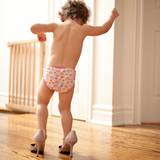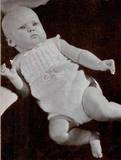Shop
01478
https://www.under5s.co.nz/shop/Hot+Topics+Articles/Clothes+%26+Shoes/Finding+the+right+kids+shoes.html
Finding the right kids shoes
|
Your child’s feet have to carry the weight of their body throughout their lifetime, and the shoes they wear in childhood can make (or break) their future foot health. Neglecting foot health invites not only future foot problems, but also problems in other parts of the body, such as the legs and back.
|
You might also be interested in ...
Is it ok for kids to wear second hand shoes?
When kids grow out of their shoes so quickly and good shoes can be very expensive to buy, second hand shoes and passing shoes down from one child to another seems like a good option. However there are a couple of things you need to bear in mind as the shoes your little one wears in childhood can make (or break) their future foot health.
Wool in the history of baby clothing
Wool is a huge part of our New Zealand heritage. Sheep farming was once the back-bone of New Zealand’s economy and wool was well known to be the best fibre to keep our babies warm. Mothers all knew how to knit and wool was endorsed as a ‘must have’ for clothing.
join usJoin us on social media for all our latest news. |
sign upSign up and receive our latest newsletters. |
|







Your child’s feet have to carry the weight of their body throughout their lifetime, and the shoes they wear in childhood can make (or break) their future foot health.
The bones in a child’s feet are formed from soft, pliable cartilage which doesn’t solidify into bone until approximately 5 years of age.
During those crucial first few years the foot needs as much room as possible to grow and form naturally, without being moulded by ill-fitting shoes.
Neglecting kids foot health invites not only future foot problems, but also problems in other parts of their body, such as their legs and back.
Barefoot is best
Barefoot walking helps form our balance, movement systems, and posture for life.
It’s essential for natural development of baby feet, and experts say that a child's foot will develop more naturally the longer he/she is allowed to walk without shoes, so let them be barefoot as often as possible.
Barefoot may be best, but there are some times when shoes are important – for warmth, for protection, and also sometimes for decoration.
Use shoes when necessary, and for those times make sure you choose good-quality shoes that fit your child’s foot properly.
Measuring your child’s feet
To find out the correct size shoe for your child, you need to know the size of their feet.
The fastest and most efficient way to go about measuring kids feet is by getting them to stand on a piece of paper and drawing lines at the front and the back of their foot, and then measuring the lines.
If your child isn’t standing yet, apply pressure to the foot when drawing the lines, as the foot spreads quite a lot with weight on it.
Make sure to measure both feet as they’re likely to be different lengths.
Allow enough ‘wiggle room’
You may have heard of the ‘rule of thumb’ when buying your shoes – it’s the rule that there should be a thumb-length between your toes and the end of the shoe (which is approx 12-16mm).
However, for little kids, that’s just too much length at the end of a foot which might only be 12cm or so, and the extra length creates a trip hazard.
We recommend adding 5mm until their feet reach a length of about 15cm or they’re walking confidently.
Once they reach that 15cm mark you can start adding a full 1cm and then rounding up. (Rounding up means 5mm or 1cm is the MINIMUM amount you should add for ‘wiggle room’).
Ignore shoe sizes
Now you know what size feet your child has, you can look for the right size shoes.
However as an Austrian study found that 97% of marked shoe sizes are wrong (some by up to 2cm), you can’t rely on the marked shoe size. The inner length measurement is the ONLY measurement that counts.
To find the inner length measurement, take a tape measure with you and physically measure inside the shoe - or if it has a removable sole, you can pull that out and measure it.
Remember that the inner length measurement you’re looking for should be at least 5mm longer than your baby’s longest foot length.
They look quite big, is that right?
Once you’ve bought the right-sized shoes, you might put them on your toddler and think “Gosh, they look way too big”. That’s NORMAL.
By the time your baby turns one, their feet will be almost half of their adult foot size. This means that little feet shod in good-fitting spacious shoes can look rather large.
It’s very hard to buy dainty toddler shoes, and for good reason – toddlers don’t have dainty feet.
This is a much more serious problem for little girls, and as a result women tend to have four times as many foot problems as men in later life.
By all means choose the cutest shoes you can find, but without compromising on space for your child’s feet to grow properly. Expect them to look a little big for your child. It’s perfectly normal.
What to look for in a good-quality pair of shoes:
They should be foot-shaped
They should be breathable
They should be flexible
They should have a back – even summer styles
Kid’s feet grow like weeds, so measure measure MEASURE
Everyone knows that children's feet grow fast, but infant feet grow the fastest of all.
That’s why it’s SO important to measure your child’s feet – and the inside of their shoes – at least every season, but preferably every month.
Consider yourself lucky if shoes last a season! We know that can make it very expensive, but it’s better to have good-fitting ‘cheap’ shoes than too-small ‘expensive’ shoes. Price is not always an indicator of quality.
As the central nervous system isn’t fully developed yet so your child actually can’t feel when shoes are squashing or damaging them – it doesn’t hurt – so YOU need to be the one that checks if they fit properly.
So measure often, and measure both the feet AND the current shoes to make sure they still fit.
You need to increase shoe size BEFORE your child’s toes touch the end of the shoes.
The 20th pair of shoes is just as important as the 1st
First shoes are important, but so is every pair of shoes until your child is at least 5 years old.
Choose good-quality well-fitting shoes for the first 5 years of your child’s life, and you’ll set them up for a lifetime of healthy feet.
Like the article you've just been reading? Click on the Refer A Friend link at the top of the page and send the details to friends who might like to read it too.Tell your friends
More Hot Topics for you to enjoy
Source: This article was written by Bugalugz - little shoes at little prices